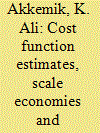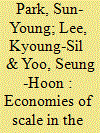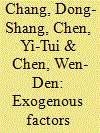|
|
|
Sort Order |
|
|
|
Items / Page
|
|
|
|
|
|
|
| Srl | Item |
| 1 |
ID:
088044


|
|
|
|
|
| Publication |
2009.
|
| Summary/Abstract |
Turkish electricity sector has undergone significant institutional changes since 1984. The recent developments since 2001 including the setting up of a regulatory agency to undertake the regulation of the sector and increasing participation of private investors in the field of electricity generation are of special interest. This paper estimates cost functions and investigates the degree of scale economies, overinvestment, and technological progress in the Turkish electricity generation sector for the period 1984-2006 using long-run and short-run translog cost functions. Estimations were done for six groups of firms, public and private. The results indicate existence of scale economies throughout the period of analysis, hence declining long-run average costs. The paper finds empirical support for the Averch-Johnson effect until 2001, i.e., firms overinvested in an environment where there are excess returns to capital. But this effect was reduced largely after 2002. Technological progress deteriorated slightly from 1984-1993 to 1994-2001 but improved after 2002. Overall, the paper found that regulation of the market under the newly established regulating agency after 2002 was effective and there are potential gains from such regulation.
|
|
|
|
|
|
|
|
|
|
|
|
|
|
|
|
| 2 |
ID:
150395


|
|
|
|
|
| Summary/Abstract |
This paper aims to investigate the cost efficiency of South Korea’s district heating (DH) system by using a variable cost function and cost-share equation. We employ a seemingly unrelated regression model, with quarterly time-series data from the Korea District Heating Corporation (KDHC)—a public utility that covers about 59% of the DH system market in South Korea—over the 1987–2011 period. The explanatory variables are price of labor, price of material, capital cost, and production level. The results indicate that economies of scale are present and statistically significant. Thus, expansion of its DH business would allow KDHC to obtain substantial economies of scale. According to our forecasts vis-à-vis scale economies, the KDHC will enjoy cost efficiency for some time yet. To ensure a socially efficient supply of DH, it is recommended that the KDHC expand its business proactively. With regard to informing policy or regulations, our empirical results could play a significant role in decision-making processes.
|
|
|
|
|
|
|
|
|
|
|
|
|
|
|
|
| 3 |
ID:
159052


|
|
|
|
|
| Summary/Abstract |
Recent empirical studies suggest that the negative correlation between the quantity of children within a family and their educational attainment, which is widely observed in developed countries, is inconsistent or even rejected in developing countries. This paper aims to integrate these divergent empirical results into a unified theoretical framework by introducing scale economies into the classical model of Becker and Lewis (1973). As a result, the “anomaly” of an observed upward or an inverted U-shaped relationship can be expected as the scale economies effect dominates when there are few children in a family. Using data from the China's 1990 and 2000 censuses, this study further tests some hypotheses induced from the model. Educational attainment increases with sibling size at first and then drops. Children with one or two siblings achieve the highest education during the period our sample covers. The inverted U-shaped correlation is more robust for rural subsamples, for older cohorts and for economically underdeveloped regions and groups, which is consistent with the prediction of the model.
|
|
|
|
|
|
|
|
|
|
|
|
|
|
|
|
| 4 |
ID:
092829


|
|
|
|
|
| Publication |
2009.
|
| Summary/Abstract |
This paper employs a stochastic frontier analysis (SFA) to examine cost efficiency and scale economies in Taiwan Power Company (TPC) by using the panel data covering the period of 1995-2006. In most previous studies, the efficiency estimated by the Panel Data without testing the endogeneity may bring about a biased estimator resulting from the correlation between input and individual effect. A Hausman test is conducted in this paper to examine the endogeneity of input variables and thus an appropriate model is selected based on the test result. This study finds that the power generation executes an increasing return to scale across all the power plants based on the pooled data. We also use installed capacity, service years of the power plant, and type of fuel as explanatory variable for accounting for the estimated cost efficiency of each plant by a logistic regression model to examine the factor affecting the individual efficiency estimates. The results demonstrate that the variable of installed capacity keeps a positive relationship with cost efficiency while the factor of working years has a negative relationship.
|
|
|
|
|
|
|
|
|
|
|
|
|
|
|
|
| 5 |
ID:
127198


|
|
|
|
|
| Publication |
2014.
|
| Summary/Abstract |
This paper studies the cost structure of Swiss gas distribution utilities. Several econometric models are applied to a panel of 26 companies over 1996-2000. Our main objective is to estimate the optimal size and scale economies of the industry and to study their possible variation with respect to network characteristics. The results indicate the presence of unexploited scale economies. However, very large companies in the sample and companies with a disproportionate mixture of output and density present an exception. Furthermore, the estimated optimal size for majority of companies in the sample has shown a value far greater than the actual size, suggesting remarkable efficiency gains by reorganization of the industry. The results also highlight the effect of customer density on optimal size. Networks with higher density or greater complexity have a lower optimal size
|
|
|
|
|
|
|
|
|
|
|
|
|
|
|
|
| 6 |
ID:
177412


|
|
|
|
|
| Summary/Abstract |
Irradiated or Spent Nuclear Fuel (SNF, where it could be “used nuclear fuel” if reprocessing facilities are available) is periodically removed from nuclear power reactors and allowed to decay in suitable storage facilities. This paper attempts to calculate the relationships between sizes and costs of wet/dry and onsite/offsite SNF storage. The methodology is (1) to propose cost models based on publicly available data and (2) to estimate cost equations to compare the various storage costs. When the fuel pool nears capacity, the cheapest alternative is to transfer SNF to onsite dry storage. Once a nuclear power plant has been decommissioned, and only the onsite dry storage facility remains, there appears to be little economic reason (from the nuclear power plant owner/operator’s viewpoint) to move the SNF to consolidated facilities because of extra monetary and non-monetary costs. Unless there are explicit national policies and funded programs to manage SNF, there are likely to be legacy sites with stranded SNF. On the other hand, there is a consensus that consolidated facilities (1) would be more safe and secure than dispersed onsite storage locations, (2) would facilitate final disposal, and (3) might reduce the risks perceived by local communities of storing SNF.
|
|
|
|
|
|
|
|
|
|
|
|
|
|
|
|
| 7 |
ID:
121277


|
|
|
|
|
| Publication |
2013.
|
| Summary/Abstract |
This study examines the cost structure of Japanese electric power industry to investigate whether a structural reform on the industry really enhances a cost-saving benefit to consumers. A composite cost function model, using a panel data set, is used for this study. The data set consists of nine electric power companies from 1990 to 2008. Based upon the estimation results, this study examines whether economies of scale and vertical economies exist in the industry. Then, this study conducts a cost subadditivity test that is a necessary condition of natural monopoly. The empirical results indicate that the electric power firms exhibit the status of economies of scale in their transmissions and distributions and the operation as a whole. However, they do not exhibit economies of scale in their generations. Thus, the transmission operation, by integration, in a large area can improve its economic efficiency. Furthermore, the industry should introduce more competition in both generation and wholesale power markets where more firms can participate in their power trades. This study also empirically confirms that vertical economies have existed in the industry. Moreover, this study confirms that all the estimates in the cost subadditivity test satisfy the necessary condition of natural monopoly, where each estimate indicates cost saving in cost subadditivity. The test does not guarantee a sufficient condition of natural monopoly. However, it clearly indicates that the functional separation between generation and transmission will increase total production cost in the industry. The complete separation may result in a net loss of economic efficiency if a competition benefit does not exceed an expected economic loss. Consequently, this study suggests that the industrial structure of future Japanese electric power industry should be evaluated from not only an expected benefit by introducing competition but also an unbundling cost that occurs with a loss of vertical integration.
|
|
|
|
|
|
|
|
|
|
|
|
|
|
|
|
|
|
|
|
|